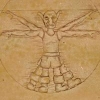Radiosity for lightmap creation?
I'm hoping to get the best visual quality in my game as I can while still allowing for low end hardware. As such I'm going to need to make use of light maps and such. I was paging through wikipedia on different light and shadow techs and Radiosity stands out as being pretty amazingly beautiful. Obviously its to intensive for realtime use, even on good hardware and wouldn't even be supported on low end stuff, much less slowly. But I was wondering, could it be used to create a realistic map of light distribution, sans animated objects, that can then be turned into a lightmap. I could then just use projected shadows for animated objects and achieve a reasonably pretty scene, in real time, on hopefully reasonable speeds on low end stuff.
So, is it possible to create a light map using Radiosity? What tools could be used to do it?
Yep, radiosity-based lightmaps have been standard from Quake to Half-Life 2 ;)
I've heard of people using the povray raytracer to make lightmaps before.
I've heard of people using the povray raytracer to make lightmaps before.
. 22 Racing Series .
Quote: Original post by Hodgman
Yep, radiosity-based lightmaps have been standard from Quake to Half-Life 2 ;)
I've heard of people using the povray raytracer to make lightmaps before.
Just wanted to specify that Quake II was the first game (AFAIK) to use radiosity and that HL2 use a special radiosity algorithm that separate incoming directions :-)
On the other side, perhaps you might want to look at HL2 radiosity: it should provide better quality, and it is fast enought to run on old hardware (I've played HL2 at max quality on a geForce 6600). I don't think that there are free tools able to output to that format though, and I don't have deeper informations to share :-(
EDIT: if HL2 normal map radiosity interests you, try this
Quote: Original post by cignox1Quote: Original post by Hodgman
Yep, radiosity-based lightmaps have been standard from Quake to Half-Life 2 ;)
I've heard of people using the povray raytracer to make lightmaps before.
Just wanted to specify that Quake II was the first game (AFAIK) to use radiosity and that HL2 use a special radiosity algorithm that separate incoming directions :-)
On the other side, perhaps you might want to look at HL2 radiosity: it should provide better quality, and it is fast enought to run on old hardware (I've played HL2 at max quality on a geForce 6600). I don't think that there are free tools able to output to that format though, and I don't have deeper informations to share :-(
EDIT: if HL2 normal map radiosity interests you, try this
Quake I used Radiosity. It was just an limited version of it (restricted number of light bounces).
---Ninja : Art of Winning
Just a little warning before you invest lot of resources and ends up frustrated by lightmap restrictions.
As already has been stated, radiosity-based lightmaps are quite common and have one of the best visual lighteffects for static lights, but...
there're lot of disadvantages of lightmaps and their use is somewhat limited.
1. They are static.
For most "level" based fps this is not a problem, but for any rpg with i.e. day-night cycle a no go.
2. Aliasing effects.
Low resolution lightmaps have strong aliasing effects.
3. High videomemory consum.
Higher resolution lightmaps consume lot of videomemory, restricting it to only "small" level or heavy streaming.
4. Lightmap packaging is difficult.
Nowaday many tools support texture baking, but there are only a few tools which support effective lightmap packaging (putting all the lightmaps into a few single large textures).
5. Only diffuse/emissive lighting is supported, you can't use it for specular or any other view dependent lighting. So, if you want to utilize any view depedent lighting effect (i.e. normal mapping), you have to use dynamic lights too.
Well, lightmaps are easy and pretty, but have many restrictions. You will encounter lightmaps most often in FPS and almost never in any open world (MMO)RPG.
As already has been stated, radiosity-based lightmaps are quite common and have one of the best visual lighteffects for static lights, but...
there're lot of disadvantages of lightmaps and their use is somewhat limited.
1. They are static.
For most "level" based fps this is not a problem, but for any rpg with i.e. day-night cycle a no go.
2. Aliasing effects.
Low resolution lightmaps have strong aliasing effects.
3. High videomemory consum.
Higher resolution lightmaps consume lot of videomemory, restricting it to only "small" level or heavy streaming.
4. Lightmap packaging is difficult.
Nowaday many tools support texture baking, but there are only a few tools which support effective lightmap packaging (putting all the lightmaps into a few single large textures).
5. Only diffuse/emissive lighting is supported, you can't use it for specular or any other view dependent lighting. So, if you want to utilize any view depedent lighting effect (i.e. normal mapping), you have to use dynamic lights too.
Well, lightmaps are easy and pretty, but have many restrictions. You will encounter lightmaps most often in FPS and almost never in any open world (MMO)RPG.
Quote: Original post by Running_Wild
Quake I used Radiosity. It was just an limited version of it (restricted number of light bounces).
This sounds new to me. Have you any source? I've played Quake I for years, and I've never seen global illumination contributes. Just lightmaps.
Quote:
5. Only diffuse/emissive lighting is supported, you can't use it for specular or any other view dependent lighting. So, if you want to utilize any view depedent lighting effect (i.e. normal mapping), you have to use dynamic lights too.
This is exactly what normal map radiosity (Half Life 2) was made for.
That said, I agree about all those limitations (and I would rather go with real time lightning) but if the OP wants to support low end or old hardware, lightmaps are most probably the only choice...
Quote: Original post by cignox1I can't remember if the Q1 light-map baking tool supported full radiosity (i.e. bounces). But seeing as the engine doesn't care how the light-maps were generated, you can use a 3rd party light-map baking tool to have static radiosity (bounced) in the Q1 engine ;)Quote: Original post by Running_WildThis sounds new to me. Have you any source? I've played Quake I for years, and I've never seen global illumination contributes. Just lightmaps.
Quake I used Radiosity. It was just an limited version of it (restricted number of light bounces).
. 22 Racing Series .
I am doing an RPG, but its isometric 3D and would need graphical capabilities approaching an RTS, ie, many mobs on screen (though not many dozen).
While normal maps, specular lighting etc are cool, a non-first person camera angle makes them not make much sense. Also, there wouldn't be a lot of opportunity in my game for spec lighting because it will be set in a swamp and a desert. few things would actually look right with it. Dunno if normal or bump maps make much sense from a isometric view, but to support lightmaps it might be best. Im still looking into all my shadow options though. I didn't realize the subjects importance to my concept till I started researching all of this.
While normal maps, specular lighting etc are cool, a non-first person camera angle makes them not make much sense. Also, there wouldn't be a lot of opportunity in my game for spec lighting because it will be set in a swamp and a desert. few things would actually look right with it. Dunno if normal or bump maps make much sense from a isometric view, but to support lightmaps it might be best. Im still looking into all my shadow options though. I didn't realize the subjects importance to my concept till I started researching all of this.
Quote:
I am doing an RPG, but its isometric 3D and would need graphical capabilities approaching an RTS, ie, many mobs on screen (though not many dozen).
While normal maps, specular lighting etc are cool, a non-first person camera angle makes them not make much sense. Also, there wouldn't be a lot of opportunity in my game for spec lighting because it will be set in a swamp and a desert. few things would actually look right with it. Dunno if normal or bump maps make much sense from a isometric view, but to support lightmaps it might be best. Im still looking into all my shadow options though. I didn't realize the subjects importance to my concept till I started researching all of this.
The usefulness of normalmapping depends not on firstperson,third person,or iso camera. Take a look at starcraft II, a rts game benefiting heavily from normal mapping.Even in a swamp or desert there are enough objects which would look better with normal mapping. Think about armor (metal,leather), monster or wet plants. Btw. not only specular lighting depends on normal mapping, diffuse lighting too .
Back to the shadow/lighting topic. In a large RPG world using lightmapping will most likely be a show stopper (memory consumption). From a isometric perspective a simple orthogonal shadowmap (sun) and a few dynamic (shadowless) pointlights would be a nice and easy start.
--
Ashaman
This topic is closed to new replies.
Advertisement
Popular Topics
Advertisement
Recommended Tutorials
Advertisement





